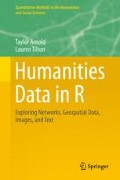Abstract
In this chapter, we introduce the concept of a network (also known as a graph). Working with a citation network build from United States Supreme Court opinions, the topics of graph drawing, centrality measures, and community detection are all explored.
Access this chapter
Tax calculation will be finalised at checkout
Purchases are for personal use only
References
Erwin Chemerinsky. Constitutional law, principles and policies (introduction to law series). New York,(NY): Aspen Publishers, 2006.
Gabor Csardi and Tamas Nepusz. The igraph software package for complex network research. InterJournal, Complex Systems:1695, 2006.
James H Fowler and Sangick Jeon. The authority of supreme court precedent. Social networks, 30(1):16–30, 2008.
James H Fowler, Timothy R Johnson, James F Spriggs, Sangick Jeon, and Paul J Wahlbeck. Network analysis and the law: Measuring the legal importance of precedents at the us supreme court. Political Analysis, 15(3):324–346, 2007.
Thomas MJ Fruchterman and Edward M Reingold. Graph drawing by force-directed placement. Software: Practice and experience, 21(11): 1129–1164, 1991.
Eric D Kolaczyk. Statistical analysis of network data: methods and models. Springer Science & Business Media, 2009.
Gregory H Maddox. Gender and famine in central tanzania: 1916–1961. African studies review, 39(01):83–101, 1996.
Sridhar Nerur, Riyaz Sikora, George Mangalaraj, and VenuGopal Balijepally. Assessing the relative influence of journals in a citation network. Communications of the ACM, 48(11):71–74, 2005.
Lawrence Page, Sergey Brin, Rajeev Motwani, and Terry Winograd. The pagerank citation ranking: Bringing order to the web. 1999.
Bruce Russett and Taylor Arnold. Who talks, and who’s listening? networks of international security studies. Security Dialogue, 41(6):589–598, 2010.
Harold J Spaeth. The Supreme Court Database. Center for Empirical Research in the Law at Washington University, 2009.
Peter Uvin. Prejudice, crisis, and genocide in rwanda. African Studies Review, 40(02):91–115, 1997.
Stanley Wasserman. Social network analysis: Methods and applications, volume 8. Cambridge university press, 1994.
Author information
Authors and Affiliations
Rights and permissions
Copyright information
© 2015 Springer International Publishing Switzerland
About this chapter
Cite this chapter
Arnold, T., Tilton, L. (2015). Networks. In: Humanities Data in R. Quantitative Methods in the Humanities and Social Sciences. Springer, Cham. https://doi.org/10.1007/978-3-319-20702-5_6
Download citation
DOI: https://doi.org/10.1007/978-3-319-20702-5_6
Publisher Name: Springer, Cham
Print ISBN: 978-3-319-20701-8
Online ISBN: 978-3-319-20702-5
eBook Packages: Mathematics and StatisticsMathematics and Statistics (R0)

